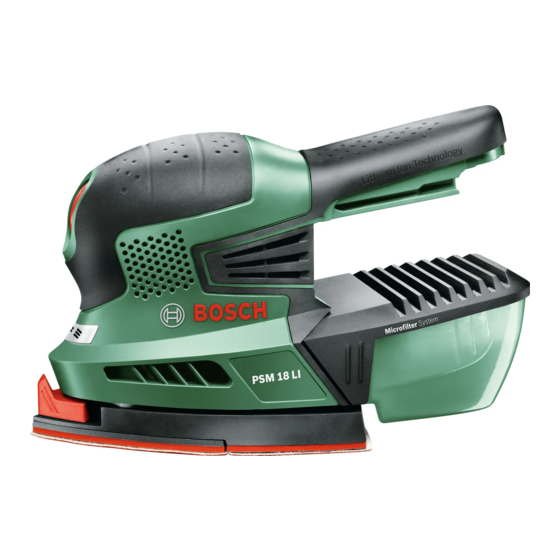Bosch PSM 18 LI Оригінальна інструкція з експлуатації - Сторінка 9
Переглянути онлайн або завантажити pdf Оригінальна інструкція з експлуатації для Електроінструмент Bosch PSM 18 LI. Bosch PSM 18 LI 10 сторінок. Cordless multi sander

OBJ_BUCH-1201-002.book Page 15 Monday, June 17, 2013 11:30 AM
Position the sanding sheet 4 flush alongside one edge of the
sanding plate 5, then lay the sanding sheet onto the sanding
plate and press firmly.
To remove the sanding sheet 4, grasp it at one of the tips and
pull it off from the sanding plate 5.
Sanding sheets of the Bosch Delta Sander can be used.
Sanding accessories, such as fleece pads/polishing cloth
pads, are attached to the sanding plate in the same manner.
Selecting the Sanding Sheet
Depending on the material to be worked and the required rate
of material removal, different sanding sheets are available:
For the working of all wooden
materials
For coarse-sanding, e. g. of rough,
unplaned beams and boards
For face sanding and planing small
irregularities
For finish and fine sanding of wood
For the working of paint/enamel
coats or primers and fillers
For sanding off paint
For sanding primer
For final sanding of primers before
coating
For reworking or polishing, especially of metal and stone, use
fleece/polishing cloth pad.
Depending on the desired surface quality of the workpiece,
different fleece types or polishing cloth pads are to be used.
Replacing the Sanding Plate (see figure F)
Slide the SDS button for release of the sanding plate 6 all
the way to the right.
Remove the sanding plate 5.
Guide the sanding plate 5 from below against the sand-
ing plate holder and firmly press them together.
Slide the SDS button for release of the sanding plate 6 all
the way to the left.
If, e. g., the front tip of the sanding sheet is worn, you can also
remove the complete sanding plate and reattach it turned by
120°.
Specialty Sanding Plates
You can replace the supplied sanding plate 5 with a specialty
sanding plate, which is available as an accessory.
The specialty sanding plate is attached in the same manner as
the one supplied.
Attach and remove the respective sanding sheets in the same
manner as when changing original sanding sheets.
Bosch Power Tools
Pad Extender (see figure G)
With the pad extender 14 you can sand surfaces that are diffi-
cult to access, such as sills on windows, cabinets or doors.
Pad Extender, Narrow (see figure H)
With the narrow pad extender 15 you can sand narrow open-
ings, slots and passages.
Pad Extender, Narrow Rounded (see figure I)
The narrow rounded pad extender 17 allows you to sand
curved and hollow areas or surfaces that are curved inward,
such as on furniture, rails or heating radiators.
Operation
Grain size
40—180
Starting Operation
Inserting the battery
Use only original Bosch lithium ion batteries with the
coarse
40
voltage listed on the nameplate of your power tool. Us-
ing other batteries can lead to injuries and pose a fire haz-
ard.
medium 80, 120
Switching On and Off
fine
180
To start the machine, push the ON/Off switch 8 downward to
40—180
position "1".
To switch off the machine, push the On/Off switch 8 upward
to positon "0".
To save energy, only switch the power tool on when using it.
coarse
40
Battery Charge-control Indication
medium 80, 120
The battery charge-control indicator 7 indicates the charge
fine
180
condition of the battery when the machine is switched on. It
consists of 3 green LEDs.
LED
Continuous lighting 3 x green
Continuous lighting 2 x green
Continuous lighting 1 x green
Slow flashing 1 x green
Temperature Dependent Overload Protection
When using as intended for, the power tool cannot be subject
to overload. When the load is too high or the allowable battery
temperature of 70 °C is exceeded, the electronic control
switches off the power tool until the temperature is in the op-
timum temperature range again.
The 3 LEDs of the battery charge-control indicator 7 flash rap-
idly when the battery temperature is not within the operating
temperature range of –20 to +70°C, and/or when the over-
load protection has responded.
Protection Against Deep Discharging
The Lithium-Ion battery is protected against deep discharging
by the "Electronic Cell Protection (ECP)". When the battery is
empty, the machine is switched off by means of a protective
circuit: The inserted tool no longer rotates.
English | 15
Capacity
≥ 66%
34—65%
11—33%
≤ 10%
2 609 007 287 | (17.6.13)
